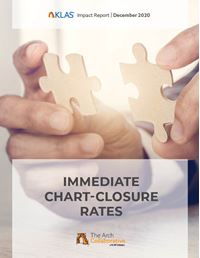Immediate Chart-Closure Rates
The percentage of charts closed immediately after patient interactions is a simple measure of a complex idea: a provider’s ability to keep up with their workload, which is influenced by time, efficiency, and many other factors. Comparing immediate chart-closure rates to other indicators suggests that providers who report higher chart-closure rates also have higher Net EHR Experience Scores and lower levels of burnout. Furthermore, closure rates also correlate with factors such as a provider’s perception of the quality of their initial EHR education and the degree to which a provider has personalized the EHR.
Want to see full details?
Want to see full details?
Here is my information:
What Correlation Exists between Chart-Closure Rates and the Following Factors?
 Net EHR Experience Score
Net EHR Experience Score
Providers who report high chart-closure efficiency have higher Net EHR Experience Scores than those who report medium or low efficiency, with providers in ambulatory care settings reporting slightly higher satisfaction across all three efficiency groups. For the purposes of this report, high charting efficiency is defined as closing more than 66% of charts immediately after patient encounters or rounds; medium efficiency is defined as immediately closing 34%–66% of charts; and low efficiency is defined as immediately closing 33% or less.

Note: The Net EHR Experience Score (NEES) is a snapshot of providers’ overall satisfaction with the EHR. The survey asks respondents to rate factors such as the EHR’s efficiency, functionality, impact on care, and so on. The NEES is then calculated by subtracting the percent of negative user feedback from the percent of positive user feedback. Scores can range from -100% (all negative feedback) to +100% (all positive feedback).
 Provider Burnout
Provider Burnout

 Initial EHR Training
Initial EHR Training
There is a positive correlation between providers’ agreement that their initial EHR training prepared them well and their chart-closure rates. Providers who strongly agree with this statement have the highest closure rates, while those who strongly disagree with this statement have the lowest. This correlation exists for both ambulatory and inpatient providers and suggests that quality training could increase providers’ charting efficiency.

 EHR Personalization
EHR Personalization



Report Non-Public HTML Body
Report Public HTML Body
Topics
Report Topics
Clinician Efficiency and Personalization, Clinician Wellness and Reducing Burnout, Nursing EHR Success, Onboarding EHR Education, Ongoing EHR EducationThis material is copyrighted. Any organization gaining unauthorized access to this report will be liable to compensate KLAS for the full retail price. Please see the KLAS DATA USE POLICY for information regarding use of this report. © 2019 KLAS Research, LLC. All Rights Reserved. NOTE: Performance scores may change significantly when including newly interviewed provider organizations, especially when added to a smaller sample size like in emerging markets with a small number of live clients. The findings presented are not meant to be conclusive data for an entire client base.



